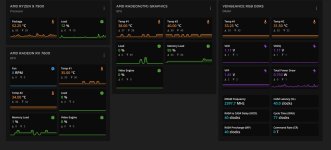Forum Man
Active member
I ran the Corsair program iCUE and got the attached dashboard results.
I have no idea what are reasonable temperatures but the 'package' Ryzen 9 temp of 50+ degree C. seems high for a no load situation on the system.
Is it normal?
FM
Case
FRACTAL DEFINE 7 BLACK QUIET MID-TOWER CASE
Promotional Item
Get a discount code for 20% off select peripherals at Corsair.com
Processor (CPU)
AMD Ryzen 9 7900 12 Core CPU (4.0GHz-5.4GHz/76MB CACHE/AM5)
Motherboard
ASUS® TUF GAMING X670E-PLUS WIFI (AM5, DDR5, PCIe 5.0, Wi-Fi 6E)
Memory (RAM)
32GB Corsair VENGEANCE RGB DDR5 5600MHz (2 x 16GB)
Graphics Card
INTEGRATED GRAPHICS ACCELERATOR (GPU)
1st M.2 SSD Drive
512GB SOLIDIGM P44 PRO GEN 4 M.2 NVMe PCIe SSD (up to 7000MB/sR, 4700MB/sW)
1st M.2 SSD Drive
2TB SOLIDIGM P41+ GEN 4 M.2 NVMe PCIe SSD (up to 4125MB/sR, 3325MB/sW)
1st Storage Drive
6TB SEAGATE IRONWOLF PRO 3.5", 7200 RPM 256MB CACHE
Power Supply
CORSAIR 750W RMe SERIES™ MODULAR 80 PLUS® GOLD, ULTRA QUIET
Power Cable
1 x 1.5 Metre UK Power Cable (Kettle Lead)
Processor Cooling
DeepCool AK620 ZERO DARK High-Performance Dual Tower CPU Cooler
Thermal Paste
STANDARD THERMAL PASTE FOR SUFFICIENT COOLING
Sound Card
ONBOARD 6 CHANNEL (5.1) HIGH DEF AUDIO (AS STANDARD)
Network Card
ONBOARD 2.5Gbe LAN PORT
USB/Thunderbolt Options
MIN. 2 x USB 3.0 & 2 x USB 2.0 PORTS @ BACK PANEL + MIN. 2 FRONT PORTS
Operating System
NO OPERATING SYSTEM REQUIRED
Operating System Language
United Kingdom - English Language
Windows Recovery Media
NO RECOVERY MEDIA REQUIRED
Office Software
FREE 30 Day Trial of Microsoft 365® (Operating System Required)
Anti-Virus
NO ANTI-VIRUS SOFTWARE
Browser
Microsoft® Edge
Warranty
3 Year Gold Warranty (2 Year Collect & Return, 2 Year Parts, 3 Year Labour)
Delivery
2 - 3 DAY DELIVERY TO REPUBLIC OF IRELAND
Build Time
Standard Build - Approximately 4 to 6 working days
Welcome Book
PCSpecialist Welcome Book
Logo Branding
PCSpecialist Logo
Packaging
PCS Common Pack Large
Price: €0.00 including VAT and Delivery
Unique URL to re-configure: https://www.pcspecialist.co.uk/saved-configurations/amd-am5-pc/pg03nSGQuY/
I have no idea what are reasonable temperatures but the 'package' Ryzen 9 temp of 50+ degree C. seems high for a no load situation on the system.
Is it normal?
FM
Case
FRACTAL DEFINE 7 BLACK QUIET MID-TOWER CASE
Promotional Item
Get a discount code for 20% off select peripherals at Corsair.com
Processor (CPU)
AMD Ryzen 9 7900 12 Core CPU (4.0GHz-5.4GHz/76MB CACHE/AM5)
Motherboard
ASUS® TUF GAMING X670E-PLUS WIFI (AM5, DDR5, PCIe 5.0, Wi-Fi 6E)
Memory (RAM)
32GB Corsair VENGEANCE RGB DDR5 5600MHz (2 x 16GB)
Graphics Card
INTEGRATED GRAPHICS ACCELERATOR (GPU)
1st M.2 SSD Drive
512GB SOLIDIGM P44 PRO GEN 4 M.2 NVMe PCIe SSD (up to 7000MB/sR, 4700MB/sW)
1st M.2 SSD Drive
2TB SOLIDIGM P41+ GEN 4 M.2 NVMe PCIe SSD (up to 4125MB/sR, 3325MB/sW)
1st Storage Drive
6TB SEAGATE IRONWOLF PRO 3.5", 7200 RPM 256MB CACHE
Power Supply
CORSAIR 750W RMe SERIES™ MODULAR 80 PLUS® GOLD, ULTRA QUIET
Power Cable
1 x 1.5 Metre UK Power Cable (Kettle Lead)
Processor Cooling
DeepCool AK620 ZERO DARK High-Performance Dual Tower CPU Cooler
Thermal Paste
STANDARD THERMAL PASTE FOR SUFFICIENT COOLING
Sound Card
ONBOARD 6 CHANNEL (5.1) HIGH DEF AUDIO (AS STANDARD)
Network Card
ONBOARD 2.5Gbe LAN PORT
USB/Thunderbolt Options
MIN. 2 x USB 3.0 & 2 x USB 2.0 PORTS @ BACK PANEL + MIN. 2 FRONT PORTS
Operating System
NO OPERATING SYSTEM REQUIRED
Operating System Language
United Kingdom - English Language
Windows Recovery Media
NO RECOVERY MEDIA REQUIRED
Office Software
FREE 30 Day Trial of Microsoft 365® (Operating System Required)
Anti-Virus
NO ANTI-VIRUS SOFTWARE
Browser
Microsoft® Edge
Warranty
3 Year Gold Warranty (2 Year Collect & Return, 2 Year Parts, 3 Year Labour)
Delivery
2 - 3 DAY DELIVERY TO REPUBLIC OF IRELAND
Build Time
Standard Build - Approximately 4 to 6 working days
Welcome Book
PCSpecialist Welcome Book
Logo Branding
PCSpecialist Logo
Packaging
PCS Common Pack Large
Price: €0.00 including VAT and Delivery
Unique URL to re-configure: https://www.pcspecialist.co.uk/saved-configurations/amd-am5-pc/pg03nSGQuY/

